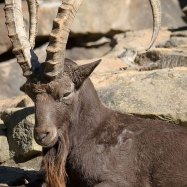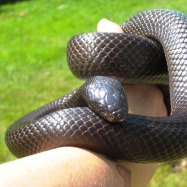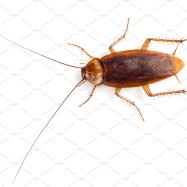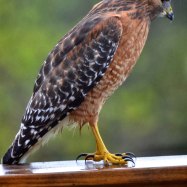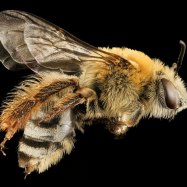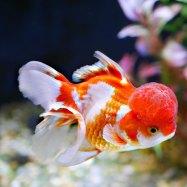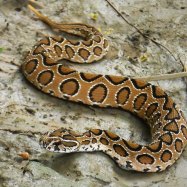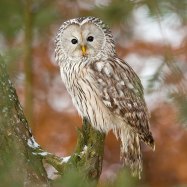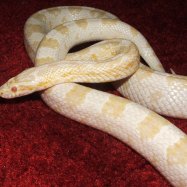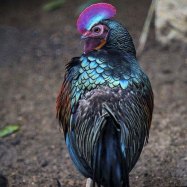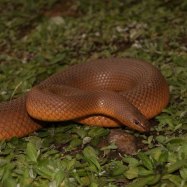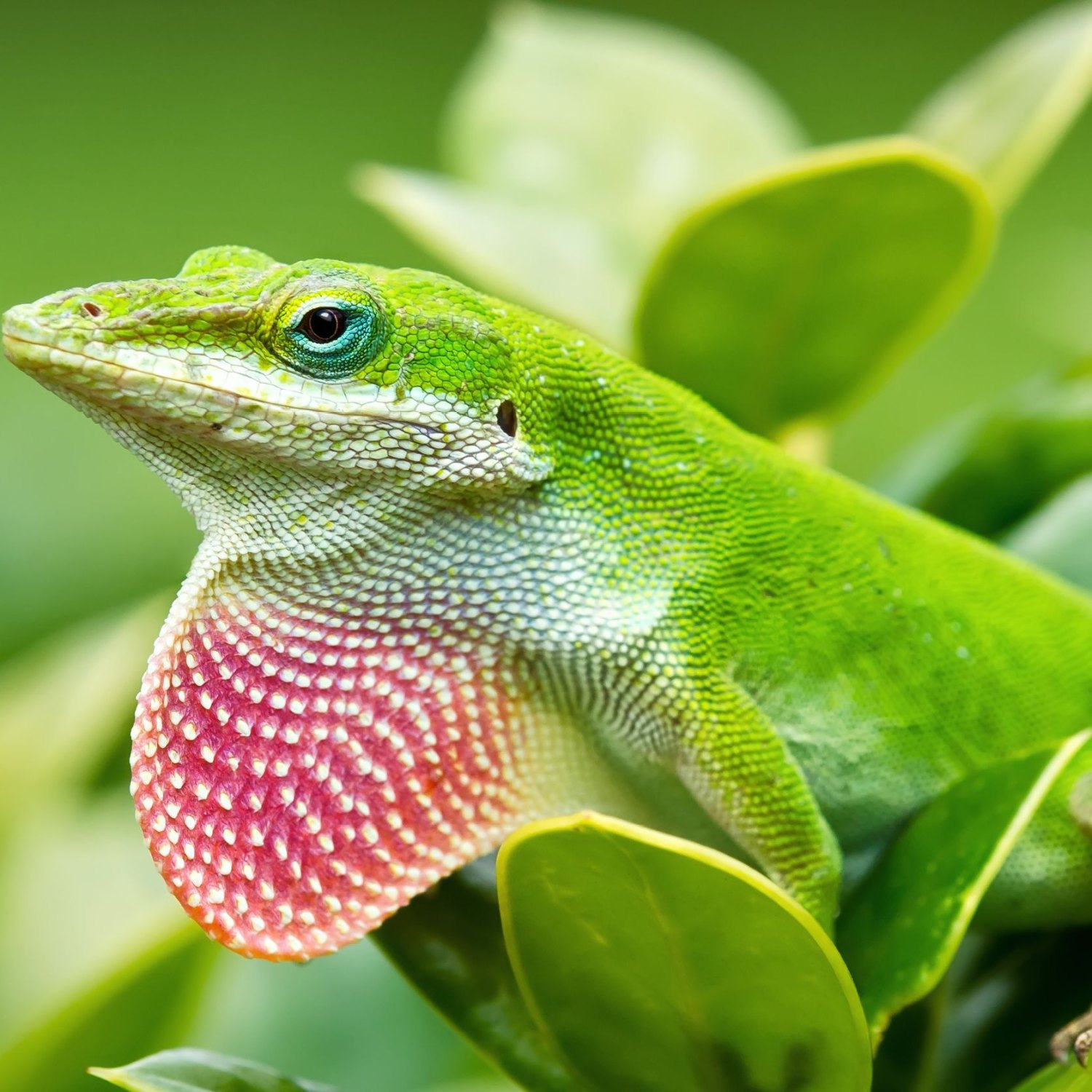
Green Anole
4.5 - 6 inches
The Green Anole, found in North America, is a popular reptile known for its slender body and long tail. With a length of 4.5-6 inches, it's a sight to behold! This friendly lizard belongs to the Dactyloidae family and is commonly kept as a pet due to its vibrant color and curious nature. Keep an eye out for these amazing creatures in your own backyard! #GreenAnole #NorthAmerica #ReptileLove
Animal Details Summary:
Common Name: Green Anole
Kingdom: Animalia
Habitat: Trees, shrubs, and low vegetation in woodlands, forests, and suburban areas
The Fascinating Green Anole: A Jewel of the Southeastern United States
The southeastern United States is known for its rich biodiversity, with an array of unique and fascinating animals populating its various habitats. One such animal that stands out with its vibrant green color and unique behavior is the Green Anole (Anolis carolinensis). Also known as the American chameleon, this reptile is a favorite among reptile enthusiasts for its fascinating characteristics. In this article, we will delve deeper into the world of the Green Anole and uncover what makes it such a captivating creature Green Anole.Origins and Habitat
The Green Anole is a member of the Animalia kingdom and belongs to the phylum Chordata. As its name suggests, it is commonly found in the southeastern region of the United States, particularly in states like Texas, Louisiana, Georgia, and Florida. Its natural habitat includes trees, shrubs, and low vegetation in woodlands, forests, and suburban areas.However, due to its popularity as a pet, Green Anoles can now be found in many other parts of the world, including Hawaii, Puerto Rico, and the Virgin Islands. They are often introduced into new environments, but they are not invasive, as they quickly adapt and coexist with other species.
Appearance
The Green Anole is a small lizard, reaching a length of about 4.5 - 6 inches. Its slender and elongated body, coupled with its long tail, makes it a visually appealing creature. It is also sexually dimorphic, with males being slightly larger and more robust than females Galapagos Tortoise.One of the most striking features of the Green Anole is its coloration. As its name suggests, it is predominantly green, which helps it blend in with its surroundings in its natural habitat. However, it is worth noting that this color can change depending on various factors, such as mood, temperature, and surroundings. For instance, when feeling threatened or excited, they can display a dark brown or black color. The males also have a vibrant pink throat fan, known as a dewlap, which they use to attract females and communicate with other males.
Behavior and Feeding
Green Anoles are known for their restless and agile behavior. They are diurnal creatures, meaning they are most active during the day, and prefer to bask in the sun to regulate their body temperature. They are also excellent climbers, using their sharp claws to grip onto various surfaces. This allows them to move effortlessly on trees, branches, and shrubs.As insectivores, Green Anoles feed primarily on small insects, such as crickets, flies, and spiders. Being ambush predators, they use their excellent eyesight to stalk and hunt their prey. They can also use their long, sticky tongue to catch their food quickly.
Unique Features
Apart from their stunning color and behavior, Green Anoles also possess some unique features. One of the most fascinating is their ability to change color. As mentioned earlier, this change in color is not only for camouflage but also serves as a form of communication. They can display different shades of green, brown, or black, depending on their mood or surroundings. For example, males may turn brown or black during mating season to show dominance and attract females.Another unique feature of Green Anoles is their capability to regenerate lost limbs. This is a remarkable adaptation that allows them to detach their tails to escape predators and then regrow them over time. It is worth noting that the regenerated tail may not be as long or colorful as the original one.
Conservation Status
Green Anoles are classified as "least concern" on the IUCN Red List of Threatened Species. Being widespread and adaptable, they are not facing any significant threats. However, their populations have been declining in some areas due to habitat destruction and the introduction of non-native species. This serves as a reminder of the importance of preserving natural habitats and preventing the introduction of invasive species.Keeping Green Anoles as Pets
As mentioned earlier, Green Anoles are a popular choice among reptile enthusiasts as pets. However, they require specialized care, and thus, proper research should be done before bringing one home. They need a large and vertical enclosure with plenty of hiding places and perches to climb on. The temperature and humidity levels should also be carefully monitored, as they are crucial for the well-being of these creatures.It is also essential to note that Green Anoles may not be suitable pets for everyone. They are not as docile as some other types of lizards, and may not enjoy being handled often. Additionally, they have specific dietary and environmental requirements, which may be challenging for some pet owners to meet.
In Conclusion
In conclusion, the Green Anole is an incredibly intriguing creature that holds a special place in the biodiversity of the southeastern United States. From its stunning color and behavior to its unique features and adaptations, the Green Anole is undoubtedly a fascinating animal to observe and learn about. As we continue to protect our natural environments, we can ensure that this jewel of the southeastern United States thrives for generations to come.

Green Anole
Animal Details Green Anole - Scientific Name: Anolis carolinensis
- Category: Animals G
- Scientific Name: Anolis carolinensis
- Common Name: Green Anole
- Kingdom: Animalia
- Phylum: Chordata
- Class: Reptilia
- Order: Squamata
- Family: Dactyloidae
- Habitat: Trees, shrubs, and low vegetation in woodlands, forests, and suburban areas
- Feeding Method: Insectivorous
- Geographical Distribution: Southeastern United States
- Country of Origin: United States
- Location: North America
- Animal Coloration: Green with a brown dewlap
- Body Shape: Slender and elongated body with a long tail
- Length: 4.5 - 6 inches
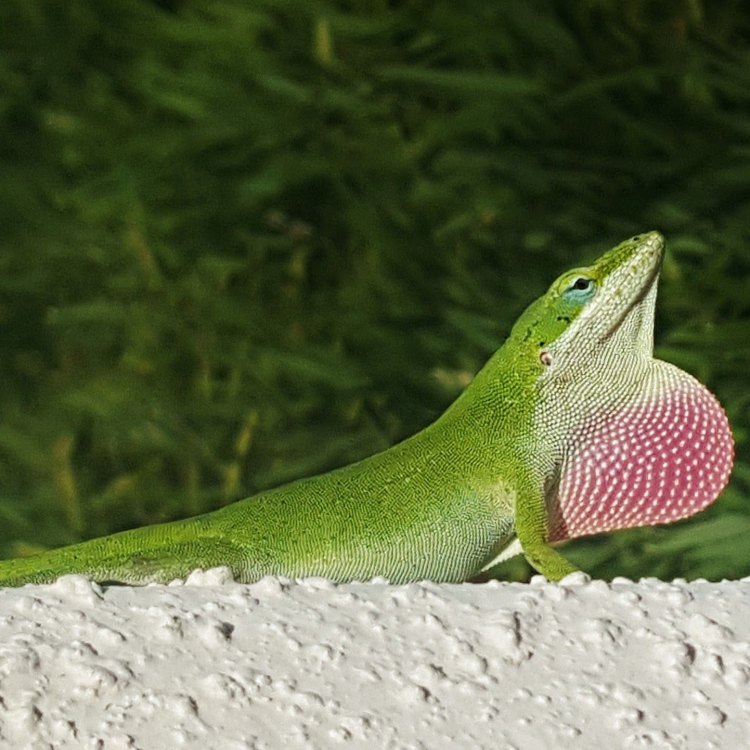
Green Anole
- Adult Size: 6 - 8 inches
- Average Lifespan: 2 - 8 years
- Reproduction: Sexual
- Reproductive Behavior: Mating and egg-laying
- Sound or Call: Males produce a chirping sound
- Migration Pattern: Non-migratory
- Social Groups: Solitary
- Behavior: Diurnal and territorial
- Threats: Habitat loss and predation
- Conservation Status: Least Concern
- Impact on Ecosystem: Control of insect populations
- Human Use: Popular pet reptile
- Distinctive Features: Long tail and ability to change color
- Interesting Facts: Can change color from green to brown depending on mood and temperature
- Predator: Birds, snakes, and larger reptiles
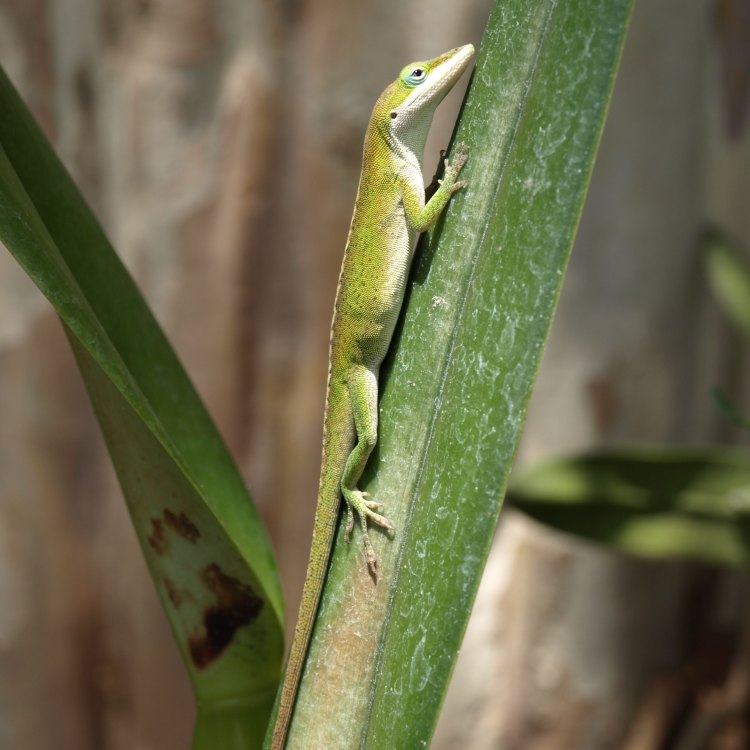
Anolis carolinensis
The Marvel of the Green Anole: Discovering the Fascinating World of a Small but Mighty Reptile
The world is filled with diverse and intriguing creatures, each with its own unique characteristics and adaptations to survive in their environment. Among these creatures is the Green Anole, a small but mighty reptile that has captured the hearts of many with its color-changing abilities and charming personality.Found in the southeastern United States, particularly in Florida and Georgia, the Green Anole (Anolis carolinensis) is a member of the lizard family. It is also known as the American Anole, red-throated anole, or Carolina anole PeaceOfAnimals.Com. With an adult size of only 6-8 inches, it may seem like an insignificant creature at first glance. However, upon further inspection, one would find that the Green Anole is a truly remarkable and fascinating species.
Survival in the Wild: Adaptations and Behaviors
The Green Anole is perfectly adapted to its environment, making it a successful survivor in the wild. Its small size allows it to maneuver easily through plants and foliage, making it difficult for predators to catch. Its long tail, which can reach up to twice its body length, also serves as a balancing tool, aiding in its agility and quick movements.One of the most distinctive features of the Green Anole is its ability to change color. This fascinating adaptation allows the anole to blend into its surroundings and hide from predators. But contrary to popular belief, the Green Anole does not change color to match its surroundings, like a chameleon. Instead, its color changes in response to its mood and temperature Gargoyle Gecko. When feeling stressed or cold, the anole may turn a darker brown color, and when relaxed or warm, it may become a bright green.
Green Anoles are diurnal, meaning they are most active during the day. They spend a large portion of their day basking in the sun to regulate their body temperature. This behavior also helps them absorb essential vitamin D from the sun, which is necessary for their survival.
Being a territorial species, male Green Anoles have been observed displaying aggressive behavior towards each other. They extend their dewlaps, which are a fold of skin under their chin, to show off their bright red throat patches. This display is a way for males to establish dominance and attract females for mating.
Mating and Reproduction
The Green Anole reproduces sexually and has a distinct mating ritual. During the breeding season, which typically occurs from April to August, the male anoles will court female anoles by nodding their head and extending their dewlaps. If the female is interested, she will nod her head in return. This dance may continue for a while until the female is ready to mate.After mating, the female anole will lay eggs, usually in a warm and moist environment. On average, a female will lay 1-2 eggs every 10-14 days, with a total clutch size of 3-4 eggs. The eggs will hatch in about 6-8 weeks, and the baby anoles will be independent within a few days.
The Importance of Green Anoles in the Ecosystem
Despite their small size, Green Anoles play an essential role in their ecosystem. As insectivores, they feed on a variety of small insects, including flies, crickets, and spiders. Their diet helps control the population of these insects, which can become pests if left unchecked. In turn, this helps maintain balance in the ecosystem.In addition, Green Anoles are also prey for a variety of birds, snakes, and larger reptiles. Being on the lower end of the food chain, they provide a food source for higher-level predators, making them an essential link in the ecosystem.
Human Interaction and Conservation
Green Anoles have been a part of human culture for decades. They are a popular pet among reptile enthusiasts due to their small size and colorful appearance. However, it is vital to keep in mind that these anoles are wild animals and should only be kept as pets by experienced owners who can provide the proper care and environment.Unfortunately, human activity, such as habitat destruction and deforestation, has had a significant impact on Green Anole populations. Their habitats, which include forests, gardens, and suburban areas, have been continuously shrinking due to urbanization and development. In addition, the introduction of non-native species, specifically the invasive brown anole, has also affected the Green Anole population.
Despite these threats, Green Anoles are still listed as a species of Least Concern on the IUCN Red List. However, conservation efforts, such as preserving their natural habitats and regulating the trade of these reptiles, are necessary to ensure their survival in the wild.
Discovering the Real Green Anole: Debunking Myths
Being a popular and well-known species, the Green Anole has been a subject of many misconceptions and myths. One prevalent myth is that they are the same as chameleons, capable of changing color to match their surroundings. As mentioned earlier, the anole changes color in response to its mood and temperature and not to camouflage itself.Another myth is that they can regenerate their tails like other lizard species. While some lizards can regrow their tails, the Green Anole is not one of them. If their tail is lost or damaged, it will not grow back, although it may regenerate a small cartilaginous structure to take its place.
A Species Worth Protecting: Appreciating the Green Anole
In conclusion, the Green Anole is a truly remarkable and captivating creature. Its small size does not diminish its significance in the ecosystem, as it plays a vital role in maintaining balance and controlling insect populations. Its ability to change color and its unique behaviors only add to its charm and make it a species worth protecting.If you ever come across a Green Anole in the wild, take a moment to appreciate its beauty and observe its fascinating behaviors. And if you are lucky enough to have one as a pet, understand the responsibilities that come with owning a wild animal and provide it with a proper and enriching environment. Let us all do our part in preserving the amazing creatures that share this planet with us.
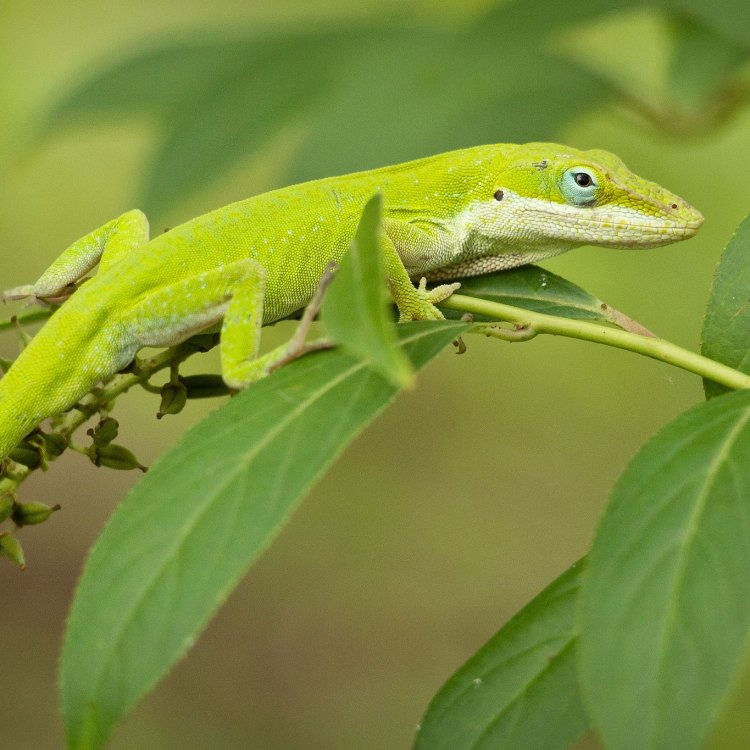
The Fascinating Green Anole: A Jewel of the Southeastern United States
Disclaimer: The content provided is for informational purposes only. We cannot guarantee the accuracy of the information on this page 100%. All information provided here may change without prior notice.

